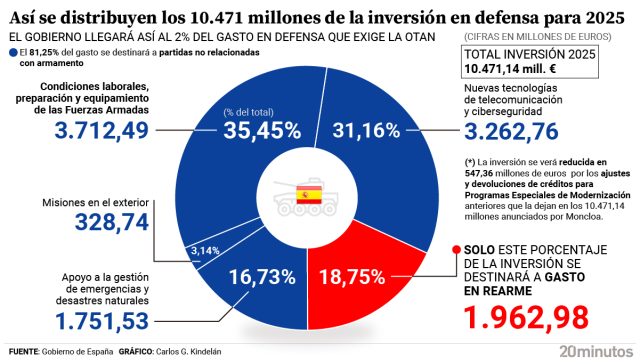“More budget against poverty and gender violence is lacking and the Ministry of Defense.” Those words were said by Pedro Sánchez in 2014, four years before being president of the Government. “I have not changed, the world has changed,” said Sánchez President precisely this week after announcingAn additional investment of 10,471 million euros to reach 2% of GDP in defensive issuesas a “commitment to the security of Europe” and within the framework of the new demands of the Take.
80% of that increase, said the president, It will be intended for salary improvements for professionals, cybersecurity and improvements in natural emergency managementwithin a definition of defense “of 360 degrees” that claims Spain but that goes beyond the limits marked by NATO itself. Just 18% will really be destined for a rearma according to the president, Although there are other items of another 2,000 million that can also be considered armed. Now, we must also look at the chronology: how has the expense in defense in Spain evolved over the last decades and, above all, what has been marking that evolution?
During Franco’s dictatorship, military spending was considerably high in proportion to GDP, although with an autarkic and limited approach in terms of advanced technology due, obviously, of the times. However, after the death of the dictator in 1975 and the democratic transition, there was an institutional reconfiguration that also affected the Armed Forces. The entry of Spain into NATO in 1982 marked a key milestone, since it was a commitment to Western military standards, which promoted a modernization process that implied a progressive increase in spending. In the mid -1980s, The defense budget represented 1.8% of GDPwith an approach in professionalization and acquisition of more modern equipment.
In the 1990s, the international context changed drastically with the end of the Cold War. Spain participated in international missions for the first time under the UN and NATO umbrella, as in Bosnia-Herzegovina (IFOR/SFOR)which meant a doctrinal and operational change for the Armed Forces. However, defense spending as a percentage of GDP remained at relatively low levels. In 1995, the expense was around 6,300 million euros, equivalent to 1.3% of GDP. Despite some investments in special weapons programs (PEAS), such as Eurofighter aircraft or Leopard cars, the emphasis remained budget containment, partly motivated by the convergence criteria for the entry into the euro.
The beginning of the 21st century brought with it a new phase. The executive of José María Aznar (1996–2004) intensified the Spanish military presence abroad, especially in Iraq and Afghanistan, which required greater operational resources, especially for the change of mentality with 11-S (The only time the NATO Mutual Defense Article 5 was activated). In parallel, more peas were developed, including F-100 frigates and armored vehicles. The expense increased slightly in absolute terms, reaching 8,500 million euros in 2008. However, the arrival of the financial crisis in that same year was a significant setback. Under the governments of José Luis Rodríguez Zapatero and later Mariano Rajoy, strong austerity measures were implemented, and the budget of the Ministry of Defense progressively fell to 5,900 million euros in 2013. This figure, however, did not include deferred payments of the PEAS, which partially masked the real expense.
Economic recovery and deterioration of the geopolitical environment promoted a new change since 2017. With the annexation of Crimea by Russia in 2014 and the increase in tensions in the eastern flank of Europe, NATO He pressed its members at the Summit of Wales to increase their investment in defense to 2% of GDP. Spain, which was among the countries that least invested proportionally, began to increase its budget again. In 2020, The official expenditure stood at 10,199 million euros, although including items in other ministries (Like PEAS credits from industry), real spending was around 12,000 million. That year, the idea of a more technological defense model was also consolidated, with bets for capacities such as drones, cyber -defense and European cooperation in projects such as FCAS (Future Fuat Air System).
The outbreak of the war in Ukraine in February 2022 was a turning point. Spain, like the rest of the European countries, accelerated its military capacities reinforcement plans. In the General Budgets of 2023, the Ministry of Defense received a record allocation of 12,317 million euros, which meant an increase of 26.3% compared to the previous year. In 2024, the budget rose again, exceeding 13,000 million euros. Despite this increase, the expense still represents around 1.2% of GDP, far from 2% committed to NATO by 2029 at that time; But the government turned and accelerated all the plans: 2025 has become the key year.
Spain, in 2%, will be placed Still in a group of partners, along with other countries such as Albania, Slovenia, Montenegro, France or Netherlandsand far from the ‘leaders’, which are Poland, Estonia, Latvia or Lithuania, according to the data of 2024, although this year all countries are expected to promote their investments as announced by the Spanish government. Poland, for example, does want to reach the aforementioned 5%, as his prime minister, Donald Tusk has already warned. The full photo gives a conclusion: the country is on its way to touring the times.






